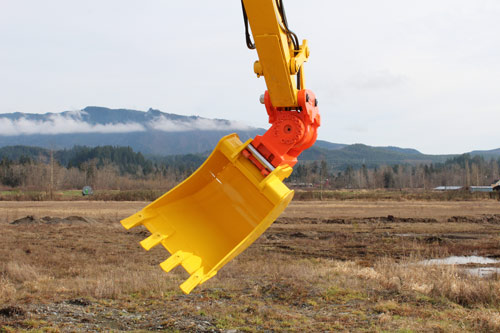 PowerTilt, a hydraulically powered construction-equipment attachment from Helac Corp., Enumclaw, Wash., lets operators of backhoes and excavators tilt any bucket or attachment side-to-side up to 180°. According to the company, users can increase productivity and versatility by simply tilting the attachment instead of moving the entire machine. It is suited for tasks like cleaning ditches, clearing land, digging beveled trenches, and positioning brushcutters, mowers, and hydraulic hammers.
PowerTilt, a hydraulically powered construction-equipment attachment from Helac Corp., Enumclaw, Wash., lets operators of backhoes and excavators tilt any bucket or attachment side-to-side up to 180°. According to the company, users can increase productivity and versatility by simply tilting the attachment instead of moving the entire machine. It is suited for tasks like cleaning ditches, clearing land, digging beveled trenches, and positioning brushcutters, mowers, and hydraulic hammers.
They come in a number of sizes designed for various maximum machine weights. Output torque ranges from 25,000 to 220,000 lb-in. and holding torque from 50,000 to 440,000 lb-in., depending on the model.
PowerTilt uses Helac’s innovative, sliding-spline operating technology to convert linear piston motion into powerful shaft rotation. Each actuator is composed of a housing and two moving parts—a central shaft and a piston. Helical spline teeth on the shaft engage matching teeth on the piston’s inside diameter. A second set of splines on the piston’s outer diameter mesh with the gear teeth in the housing.
In the starting position, the piston is completely bottomed out and the housing with integral ring gear is stationary. Applying hydraulic pressure moves the piston axially while the gearing causes the piston and shaft to simultaneously rotate. Applying pressure to the opposite port returns the piston and shaft to their original starting positions.
A two-way auxiliary hydraulic circuit is required for operation. PowerTilt models are generally manufactured with four ports: two ports (P1) and two ports (P2).This is to assist hose routing. Most PowerTilts delivered to North American customers incorporate SAE port connections. Units delivered elsewhere generally incorporate BSPP ports.
Units have displacements ranging from 32 to 277 cubic in. and require oil flow from 0.8 to 1.5 gpm in the smallest unit to 9 to 13 gpm in the largest. Circuit pressure ranges to about 3,650 to 3,750 psi with a maximum circuit back pressure of 580 psi. Most PowerTilts incorporate an integral cross-port relief valve mounted inside the shaft. Relief pressure is 3,200 to 3,300 psi.
Several configurations include the PT Series with a standard housing and welded-on ears. The lower end can be welded to a quick-coupler or bucket. Others have a housing and shaft designed for customization, such as when integrating quick-couplers at both the top and bottom. They can be attached by welding or the housing can incorporate drilled and tapped holes for bolt mounting. Custom-engineered units are also available.
Helac Corp.
helac.com
Filed Under: Mobile Hydraulic Tips, Slider